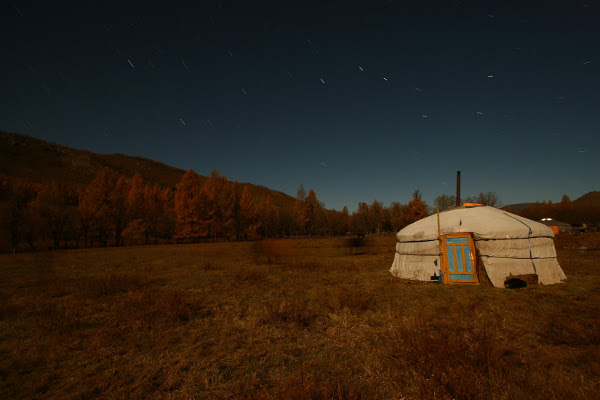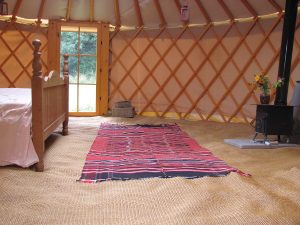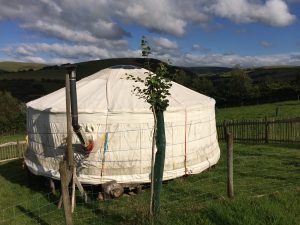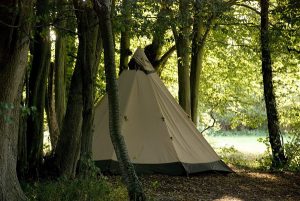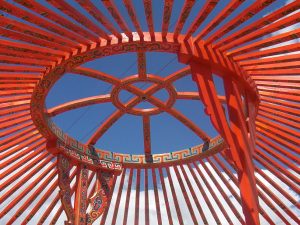Sam Ryan worked for Lowimpact.org in the UK for a year, and is now on his way overland, with his partner Dani, back home to Australia to set up Low-impact Australia over there. He’s sending us a few blog articles en route. This fourth one is about their experiences couchsurfing in yurts (gers) in Mongolia.
A yurt is a wood, felt, and canvas tent supported by an ingenious system of collapsible walls and poles leading to a central circular support. They are used by many peoples of Central Asia, who value them as the original mobile home, exceedingly well-suited to a nomadic lifestyle. In Mongolia, where my partner and I ‘couch-surfed’ in yurts for two weeks, they are called Ger’s, which literally translates to ‘home’.
Some might think it surprising that nearly
half of Mongolia’s 3 million people live in what we would call a tent, but there are many reasons for their popularity. Their usefulness to nomads as being easy and quick to erect makes them an obvious choice over traditional forms of housing, but what is surprising is how many Mongolians choose to live in gers in Ulaanbataar – the capital city. It is also shocking given that Ulaanbataar is the coldest capital city on earth, with mid-winter temperatures between -10 and -30°C.
Certainly, a ger would be practically uninhabit able without a fire, which forms the heart and center of every ger designed for habitation. In addition to providing warmth, all the family’s cooking is done on the hearth where fuel is usually fallen deadwood, or often, dried animal dung. Contrary to expectation, the dried dung itself did not smell of anything, and when burnt, it had a pleasant smoky aroma not unlike incense. To help protect against cold, the gers also had several layers of felt insulation. Because we travelled in Mongolia as autumn turned to winter, we had the pleasure of helping our couchsurfing host add extra layers of felt that Mongolians feel are unnecessary in the warm summer months, though I imagine people unused to harsh climates would rather have the extra layers all the time.
Traditionally, yurts are made of natural materials that vary according to their design and the materials available. The gers we stayed in were all made of a number of ‘walls’ (5 walls are a standard size for a family), which were a lattice of flexible timbers, connected in such a way that the wall was expanded like an accordian when put to use, but could be folded down so that all the timbers lay flat against each other when being transported or stored.There was always a central supporting crown, which the flue of the hearth’s chimneys would project through, and also acted as a skylight that gave a beautiful illumination to the interior. I thought that having no windows would feel claustrophobic and make the inside too gloomy, but because of the round space we never felt closed in, and would open the door when the weather allowed. The door of the Mongolian ger always faces south towards the sunrise, and we were told that older people are able to tell the time based on where the light hits the walls.
Finally, the poles leading from the walls to the crown form the final piece of the yurt’s architecture, and bind the whole structure together. The poles themselves are not particularly thick, but their numbers create an extraordinary strong roof, capable of withstanding immense weight as long as it is distributed evenly – perfect for thick, insulating snow. Mongolians would never ask me to climb up on the roof – my job was to hold the crown straight while the poles were gradually inserted.

Family looking at our Facebook page on a screen powered by a solar panel
Apart from the aesthetic and supreme functionality of gers, we especially enjoyed how well-suited they were to off-grid, sustainable living. Only one ger we stayed in was connected to mains electricity, which was used to power a single fluorescent bulb and a computer. Others were without electricity altogether, but our favourite option made use of a solar panel mounted on a pole to charge a battery inside. None of the gers had running water, but there were some ingenious systems for using the minimal amount of liquid possible for washing and cleaning. Upon seeing recently empty ger sites, we were amazed to see only the circular bare patch of earth where the ger was located, and a heap of animal dung nearby, both of which would soon be unrecognisable from the surrounding landscape. There are few forms of housing that are so light upon the earth.
As one would expect, a yurt is very inexpensive when compared to a conventional dwelling. Different components need replacing from time to time, but the main structure can easily last 20 years, depending on how often it is reassembled and transported. My partner and I hope to build a small house one day, and think a yurt would be an excellent halfway house, if not a semi-permanent dwelling. It is possible to buy yurts in many countries, either produced overseas, or even better, made nearby from local materials. There are also courses that show people how to make their own, though some aspects like sewing the canvas are best left to professionals.
If staying in a yurt appeals, there are many opportunities to try, not just in Mongolia (though if you do want to visit this wonderful country, the best way is surely the Trans-Mongolian Railway, accessible from Europe overland). Many accommodation providers in the UK and across Europe now have yurts as an option, especially those billing themselves as eco-retreats. Click here for more on yurts.

